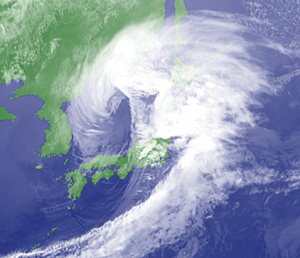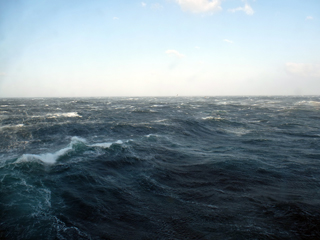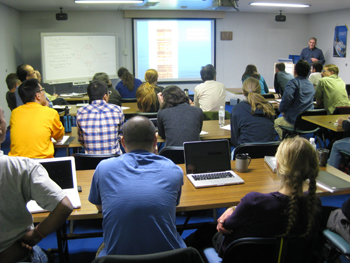

WOWApril 5, 2012
Chikyu arrived on the JFAST drill site yesterday and was greeted by typhoon-strength (30m/s) winds whipping up the Pacific into a surging mass of 8-10m high waves. The same storm has shut down airports on the mainland and left many stranded. Tasks scheduled for the drilling preparations have been delayed because the ship is rolling around too much. Fortunately the cruise here from Shimizu went well and we arrived ahead of schedule so the storm has not set things back too badly so far.

This satellite image shows the extent of the storm we are currently experiencing
(Tuesday, April 3, 2012, Japan Meteorological Agency)
Even though Chikyu is huge, being on board in this weather feels like being in an airplane in severe turbulence. Except the storm has been raging for 24 hours! Walking in straight line is a distant memory and all of the outside deck areas are currently off limits thanks to the wind. The science party has had a tough introduction to the high seas, even the old hands are impressed at the longevity of this storm! Some people seem to have been completely unaffected, but there are definitely some green faces around, mine included.

The view from the porthole. 8 ? 10 m waves are crashing constantly against the side of the boat and the swell is causing the boat to roll and rock significantly. Hopefully it will blow over soon!
Despite the conditions, the science party continues to work hard to prepare for the drilling phase of the expedition. We are in an intense planning and training phase, working around the clock. As a group we are finalizing the design of the experiment here, deciding on the optimum layout for the drill holes. Every scientist will have a specific role once the operation is underway. Each person needs to become intimate with the tools they will be using, but it is fantastic how everyone is working together and sharing experience and ideas for improving on established methods, techniques and technologies. As a newcomer to the ocean drilling program, I feel lucky to be able to work and learn from the collection of world experts that make up the science team. The learning curve is steep but it the enthusiasm of the group is amazing, and the sense of working towards a common goal is inspiring.

Legendary scientist Casey Moore explains how faults are identified in drill holes from logging data.
The first stages of the drilling operation will be incredibly exciting: an underwater TV will be lowered 7km down to the sea floor to peer around and scope out the site. The engineers will try to find two sites to locate the drill head amongst the rocks. Will there be any friendly crabs to help out? Who knows, but one thing for sure is I can’t wait for the drilling to begin!
For now the plan is to Wait Out the Weather.

















